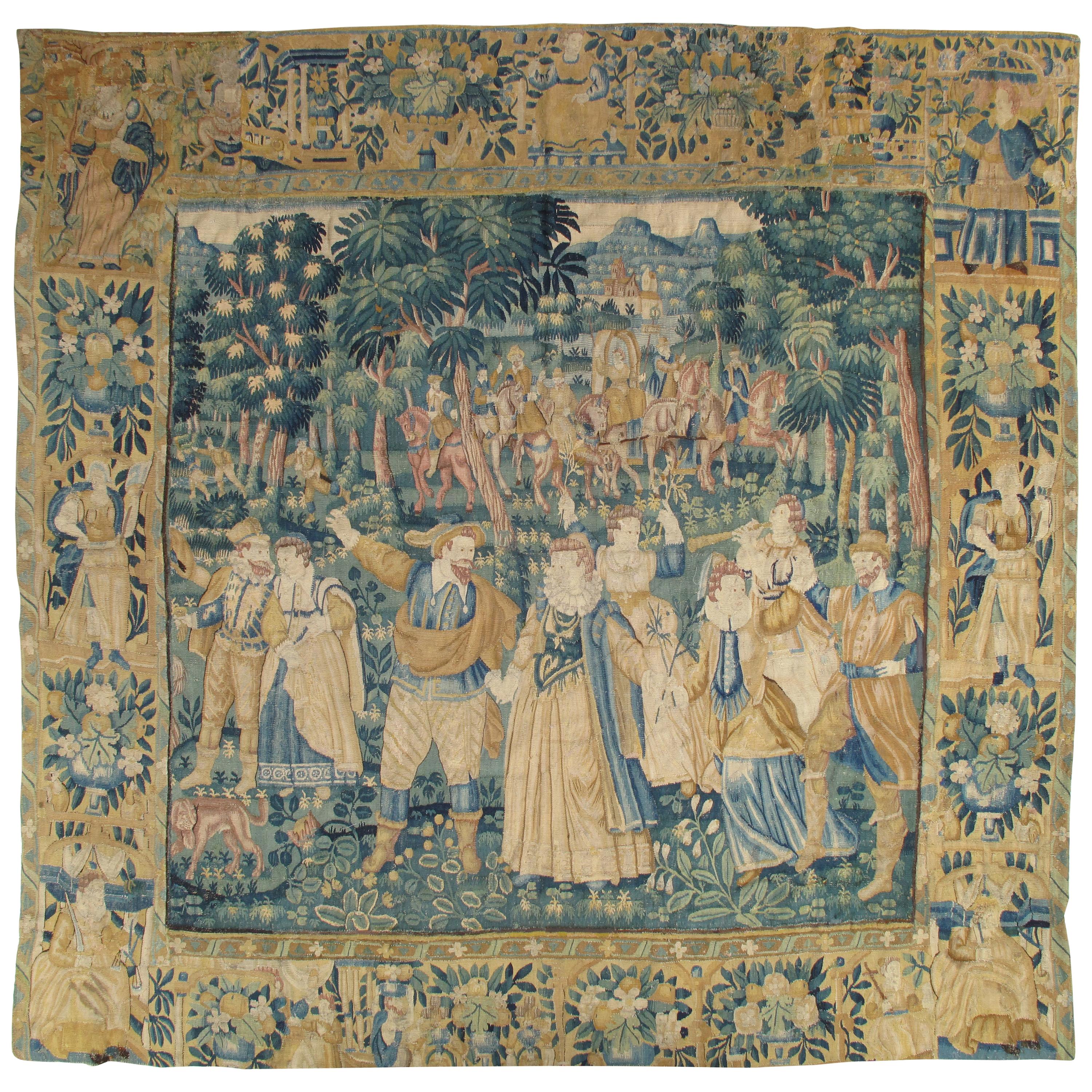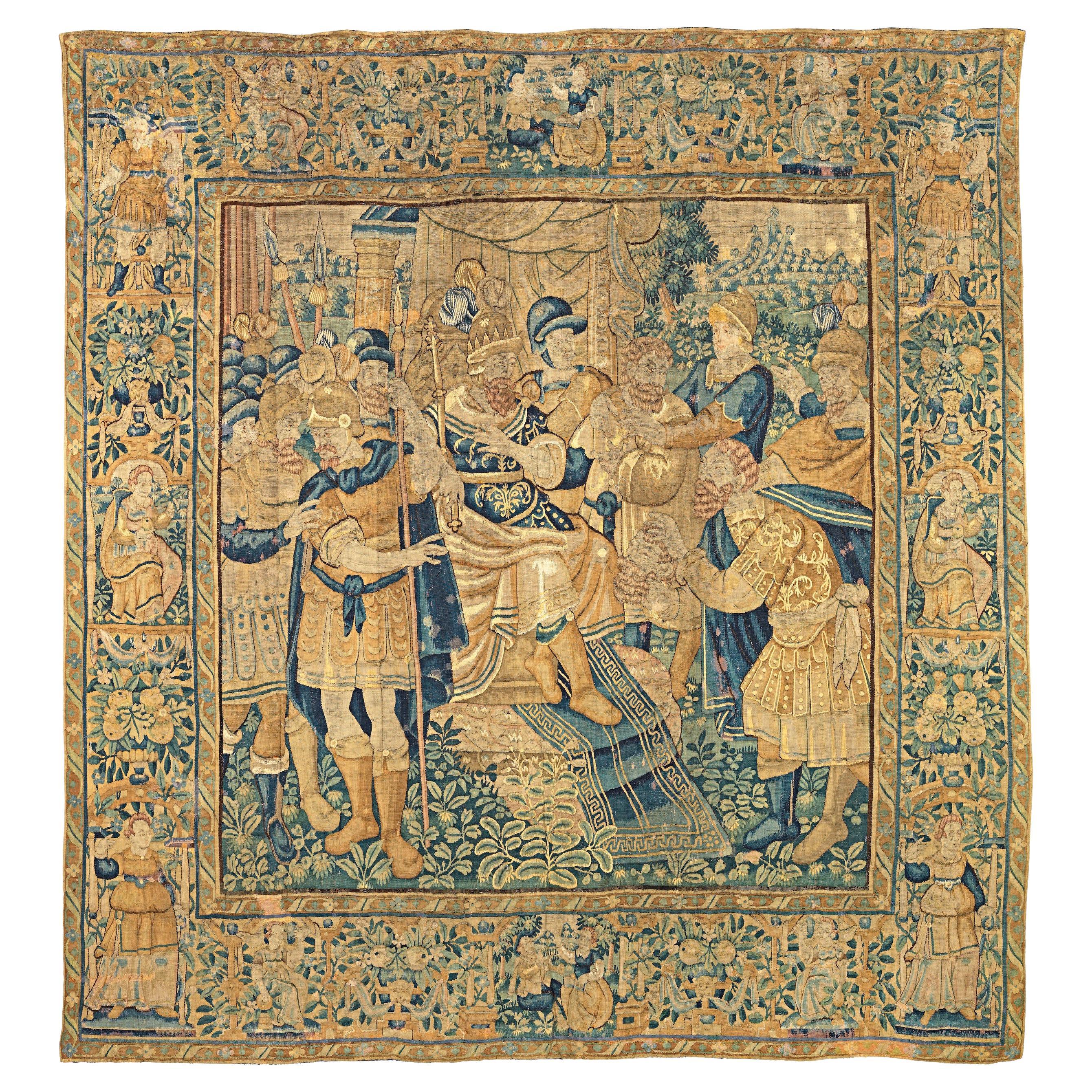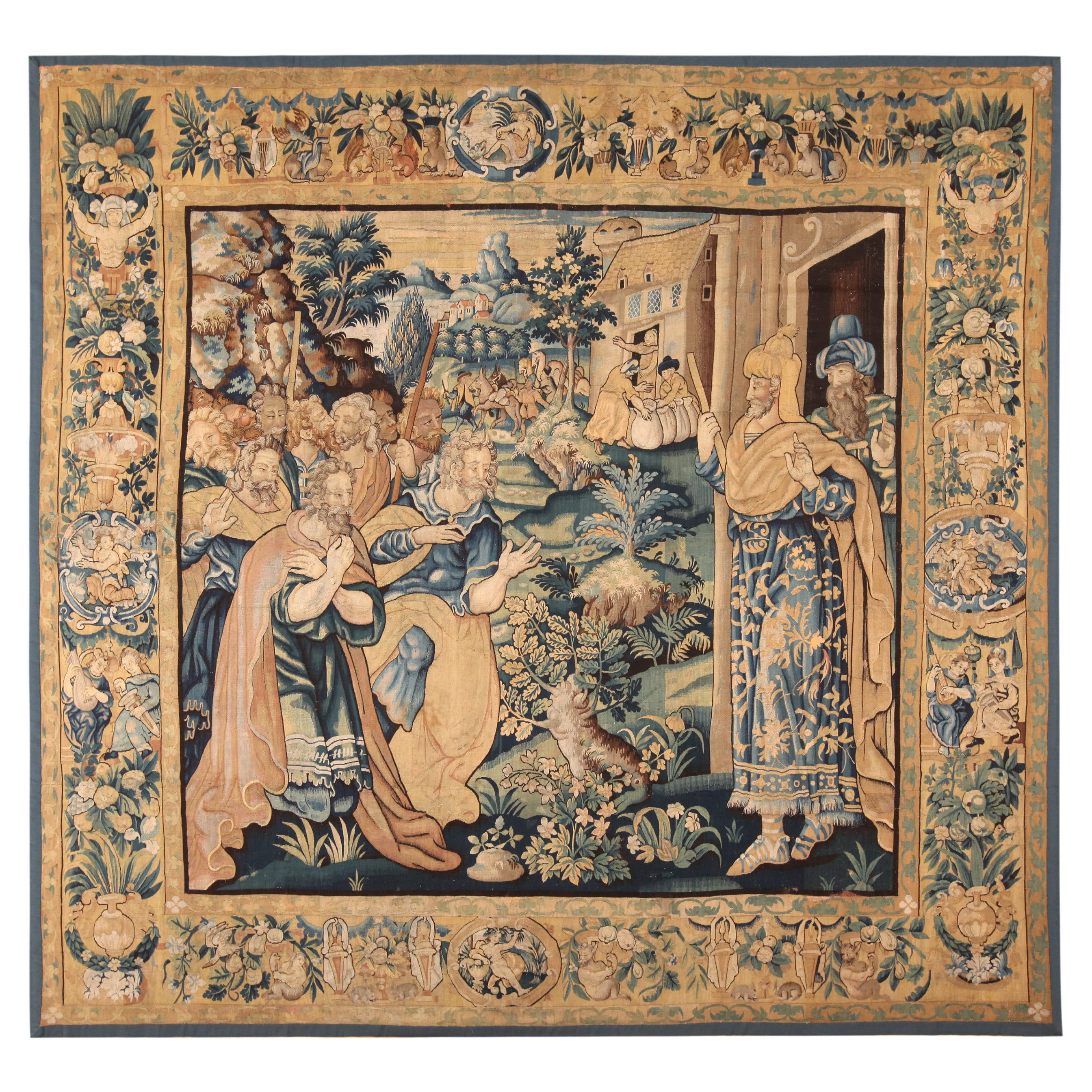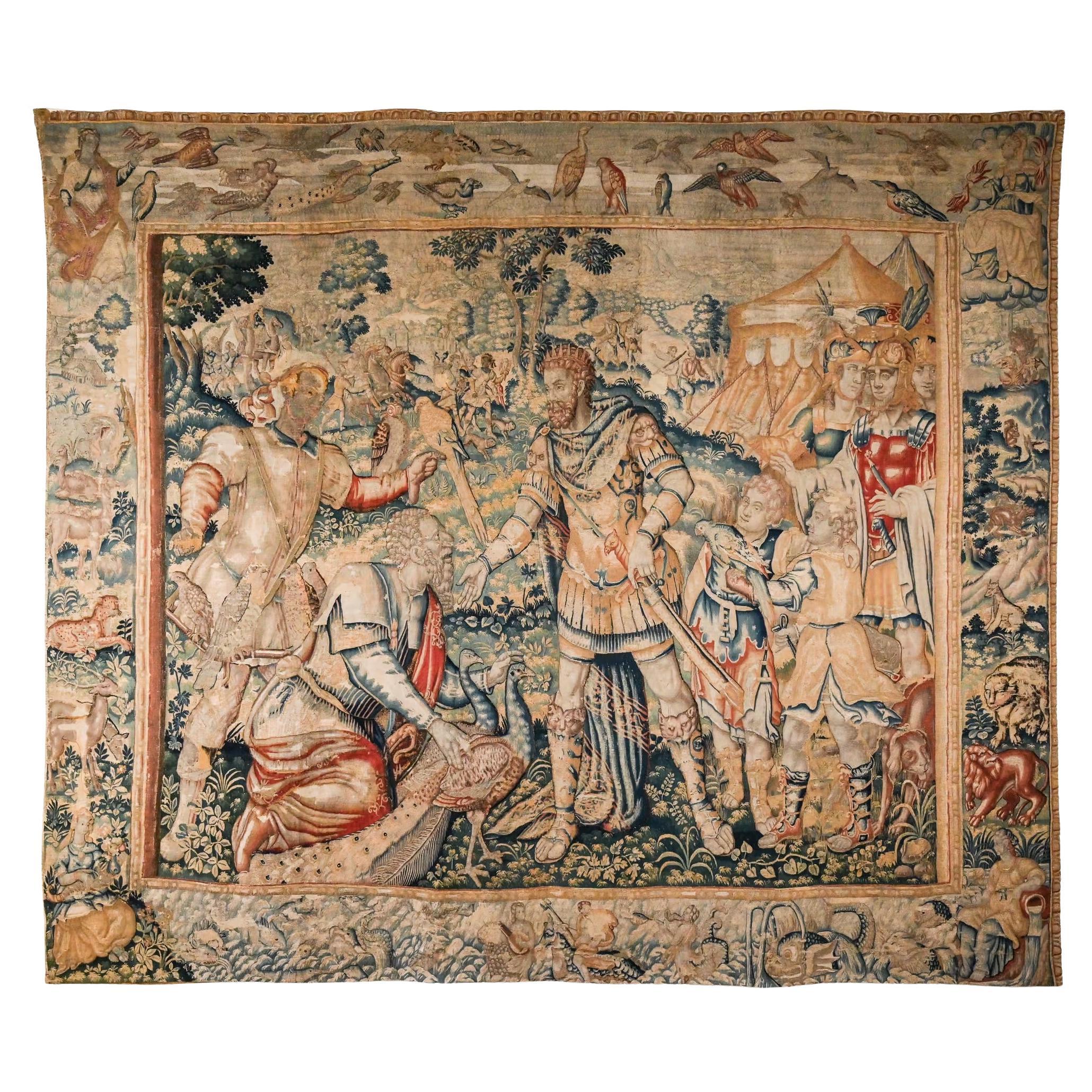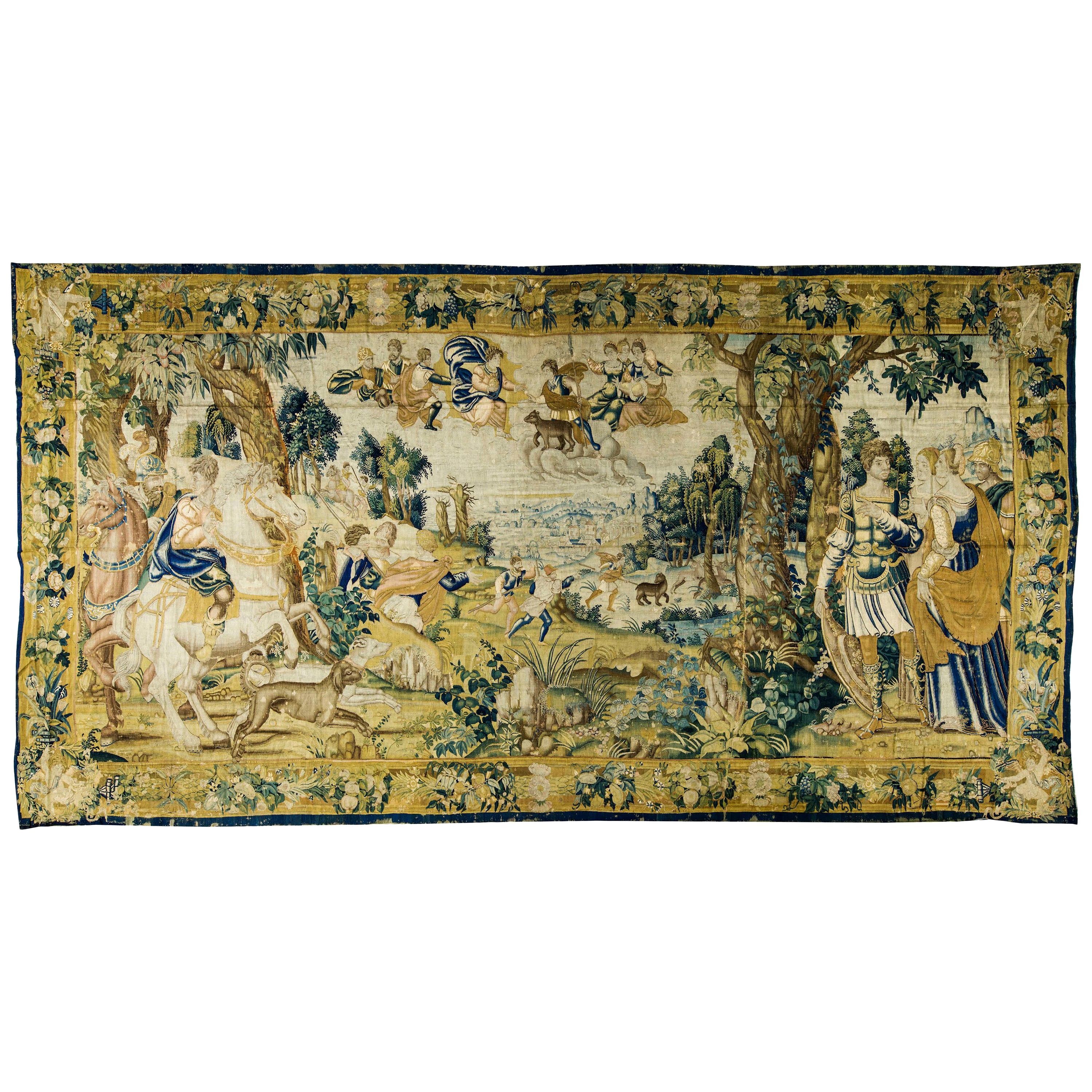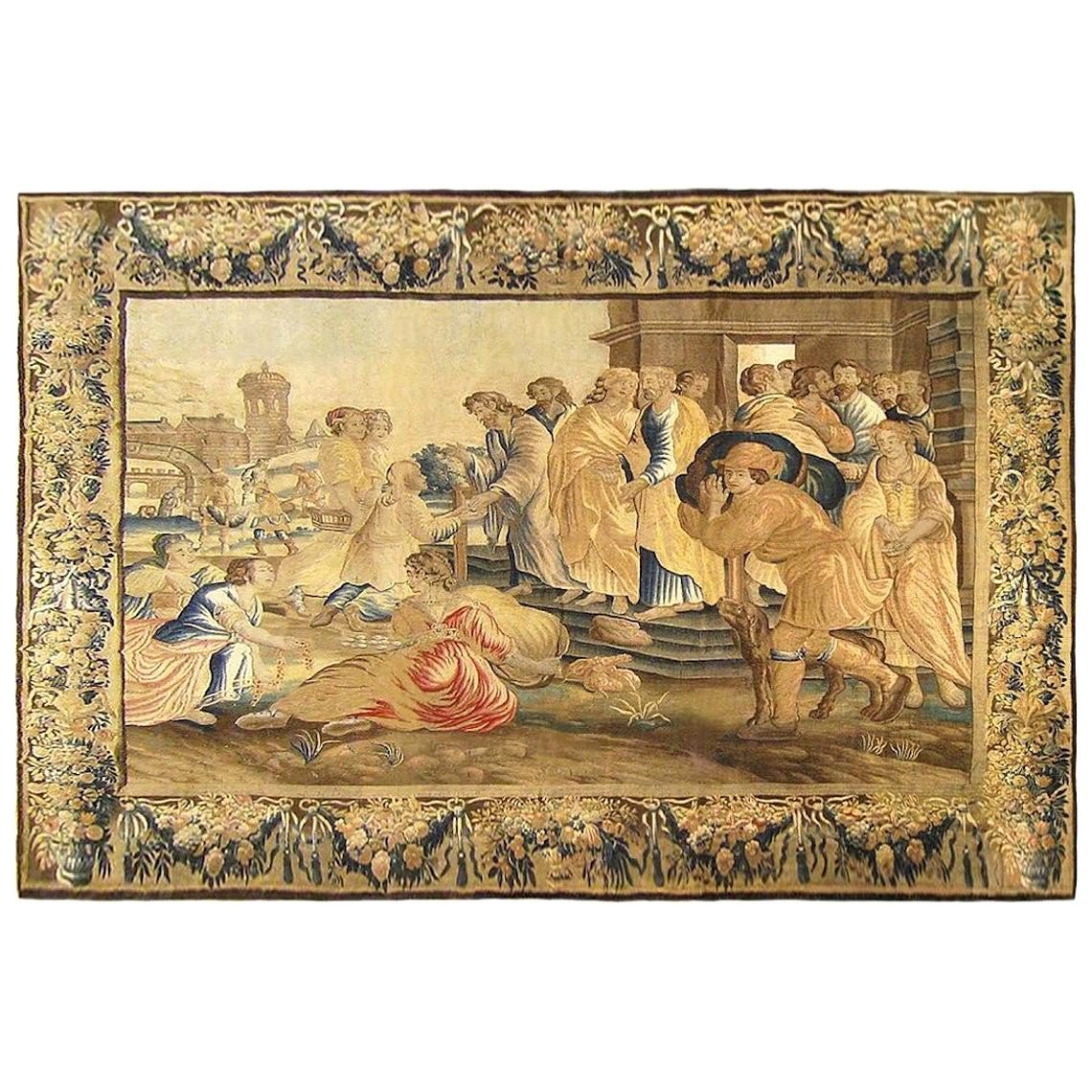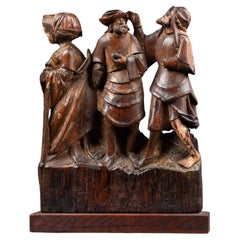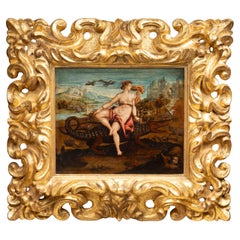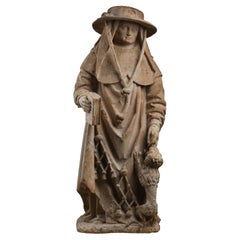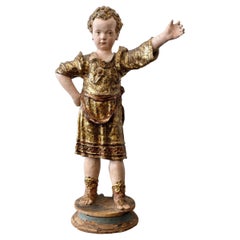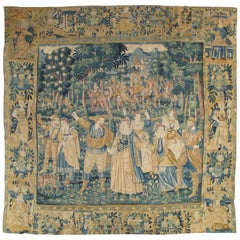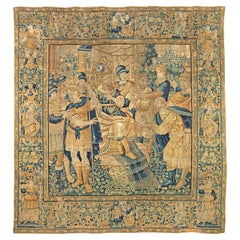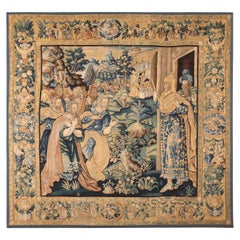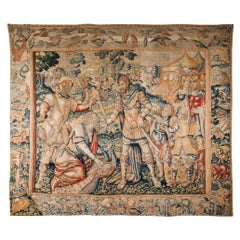Items Similar to The Martyrdom of Santa Barbara - Bruges, 1530-50
Want more images or videos?
Request additional images or videos from the seller
1 of 6
The Martyrdom of Santa Barbara - Bruges, 1530-50
$74,349.09
£55,308.22
€62,000
CA$101,809.34
A$113,198.13
CHF 59,105.82
MX$1,377,896.87
NOK 754,164.48
SEK 706,616.08
DKK 471,971.76
Shipping
Retrieving quote...The 1stDibs Promise:
Authenticity Guarantee,
Money-Back Guarantee,
24-Hour Cancellation
About the Item
The Martyrdom of Santa Barbara
Wool and silk tapestry
Bruges, 1530-50
270 x 198 cm
Expertise by Professor Guy Delmarcel
This Flemish tapestry is a remarkable example of 16th-century craftsmanship, distinguished by its exceptionally well-preserved color palette.
The medaillon-shaped center stands out against a background of dark blue roses and acanthus leaves. It depicts the martyrdom of Saint Barbara, identified by the tower where she was imprisoned. According to legend, her father, Dioscorus, is about to behead her with a scimitar, while an angel descends from the heavens to strike him with lightning.
At the bottom, beneath Saint Barbara, two fantastical creatures. On the left is a griffon depicted with the body of a lion and the head and wings of an eagle. On the right is a creature with the body of a leopard, the head of an elephant adorned in a fancy blue cloak. Both animals face each other standing either side of a green hill top in the middle of the tapestry.
The lavish scene of the tapestry is framed by a border which is embellished with foliage, flowers and fantastical elephant heads in blue and white on a red background. The corners and center of the edges display goldsmith-objects. The vibrant brick-red colour and striking bluish-green leaves create a stunning visual impact, showcasing the outstanding state of conservation.
Professor Guy Delmarcel connects this tapestry to a series of textiles produced in Bruges after 1530, characterized by their fantastical nature scenes populated with imaginative creatures. Most feature similar roses and acanthus-leaves as well as other vegetation, with wild animals appearing ready to attack. Two almost identical pieces preserved at the Art Institute of Chicago (Bruges, 336 x 599 cm) and the Rijksmuseum in Amsterdam ("Tournai," 285 x 490 cm) serve as prime examples. The entire surface is filled with greenery, along with birds and fantastic animals.
This tapestry exemplifies the rich decorative style of the time, merging naturalistic and poetic elements with exotic animals that spark the imagination.
Other works of this type follow the theme of the "Closed Garden." In the lower register, fantastical creatures occasionally appear, as seen in the exquisite Bruges Tapestry displayed at the Museum of Decorative Arts in Paris, and in the example from the Burrell Collection in Glasgow. The Parisian tapestry from Bruges features a mythical animal in the lower register, dressed in blue fabric, which closely resembles the animal in our tapestry.
If Enghien or other centers produced similar pieces, several elements suggest a stronger connection to Bruges for two formal reasons:
The overall colour-palette of our tapestry fabric characterized by pronounced brick-red colours and bluish-green leaves, aligns more closely with Bruges than with Tournai or Enghien.
The intricate border design with the warm brick-red background, adorned with floral motifs, goldsmith-inspired elements such as incense burners and small bells, can be traced back to Bruges around 1530. This style, often associated with heraldic imagery, underscores the tapestry's connection to the city's rich artistic heritage. A comparable example is the tapestry featuring the Arms of Paolo Giovio, now part of the Prince of Liechtenstein's collection in Vaduz. This piece, set against a brick-red background, depicts arms and armors, cornucopias, boys riding grotesque dolphins, as well as various flowers and leaves.
All available literature dates this group of tapestries to the second quarter of the sixteenth century. A key formal element further supports this dating: the executioner, depicted preparing to behead Barbara, wields a Turkish scimitar, a reference to the frequent Ottoman incursions into Central Europe beginning with the 1529 siege of Vienna. The historical significance of our work is further enhanced by the absence of the town mark on our tapestry. This indicates that it was woven before May 2, 1547, when the guild mandated its use.
Bruges was a preeminent weaving center during this period, with numerous tapestries documented in contemporary inventories. Unfortunately, very few have survived, which makes this work particularly rare and valuable. The exquisite craftsmanship of Bruges tapestries, witnessed in ours, has left a lasting impact on textile production throughout Europe, establishing high standards of artistic innovation.
This tapestry stands as a rare and significant artifact from Bruges, showcasing extraordinary preservation of color and design that captures the essence of its era.
Bibliography:
Guy Delmarcel, La tapisserie flamande du XVe au XVIIIe siècle , Tielt, 1999
Hartkamp - Jonxis (Ebeltje) & Smith (Hillie), European tapestries in the Rijksmuseum (catalogue of the decorative arts in the Rijksmuseum, Amsterdam. Volume 5), Amsterdam, Waanders Publisher & Rijksmuseum, 2004
Koenraad Brosens, with contributions by Pascal-François Bertrand, Charissa Bremer-David, Elizabeth Cleland, Guy Delmarcel, Nello Forti Grazzini, Yvan Maes De Wit and Christa C. Mayer Thurman (general editor), European Tapestries in the Art Institute of Chicago, New Haven – London, Yale University Press , 2008
Elizabeth Cleland & Lorraine Karafel, Tapestries from the Burrell Collection, London, Philip Wilson Publ., 2017
Monique Blanc , Tapisseries de la Renaissance. Collection du Musée des Arts Décoratifs, Paris, 2019
- Dimensions:Height: 106.3 in (270 cm)Width: 77.96 in (198 cm)Depth: 0.12 in (3 mm)
- Style:Renaissance (Of the Period)
- Materials and Techniques:
- Place of Origin:
- Period:
- Date of Manufacture:16th century
- Condition:Rewoven. Wear consistent with age and use. restoration visible on the border.
- Seller Location:Bruxelles, BE
- Reference Number:1stDibs: LU6666243893382
About the Seller
5.0
Vetted Professional Seller
Every seller passes strict standards for authenticity and reliability
1stDibs seller since 2022
15 sales on 1stDibs
Typical response time: 2 hours
- ShippingRetrieving quote...Shipping from: Bruxelles, Belgium
- Return Policy
Authenticity Guarantee
In the unlikely event there’s an issue with an item’s authenticity, contact us within 1 year for a full refund. DetailsMoney-Back Guarantee
If your item is not as described, is damaged in transit, or does not arrive, contact us within 7 days for a full refund. Details24-Hour Cancellation
You have a 24-hour grace period in which to reconsider your purchase, with no questions asked.Vetted Professional Sellers
Our world-class sellers must adhere to strict standards for service and quality, maintaining the integrity of our listings.Price-Match Guarantee
If you find that a seller listed the same item for a lower price elsewhere, we’ll match it.Trusted Global Delivery
Our best-in-class carrier network provides specialized shipping options worldwide, including custom delivery.More From This Seller
View AllGroup of Altarpiece - Antwerpen, 16th century
Located in Bruxelles, BE
Group of altarpiece representing the life of a Saint, Saint Renualde?
Engraved by the sign of Antwerp hand on the hat of the central character
Carved oak, traces of polychromy
Fir...
Category
Antique 16th Century Belgian Renaissance Figurative Sculptures
Materials
Oak
$15,349 Sale Price
20% Off
Allegory of Africa - 16th century
Located in Bruxelles, BE
Flemish school of the 16th century
Allegory of Africa
After The Allegories of the Continents by Maerten de Vos (engraving by Adriaen Collaert)
Oil on copper
Inscription: "Giulio Ro...
Category
Antique 16th Century Belgian Renaissance Paintings
Materials
Copper
Followers of Jean de la Huerta, Jean de Blany ? - Saint Jerome
Located in Bruxelles, BE
Followers of Jean de la Huerta, Jean de Blany ?
Saint Jerome
Limestone
Burgundy, second half of the15th century
60,5 cm
ALR Ref : S00248050
This exquisite sculpture of Saint Jerome, carved from soft, nearly white limestone typical of eastern France, exemplifies the exceptional craftsmanship of 15th-century Burgundian art. The figure of Saint Jerome, a key figure in Christian history renowned for translating the Bible into Latin, is depicted wearing a cardinal’s hat and holding the Vulgate Bible...
Category
Antique 15th Century and Earlier French Renaissance Figurative Sculptures
Materials
Limestone
Cercle of Romano Alberti, Page, Around 1530-1540
Located in Bruxelles, BE
Cercle of Romano Alberti, dit Il Nero da Sansepolcro ( San Sepolcro, 1521-1568 )
Page
Mixed media : wood core, papier mâché, stucco, polychrome and gilded
Italy, around 1530-154...
Category
Antique 16th Century Italian Renaissance Figurative Sculptures
Materials
Stucco, Wood, Paper
$12,471 Sale Price
35% Off
Christ - Umbria, second half of the 15th century
Located in Bruxelles, BE
Christ
Umbria, Orvieto?
Second half of the 15th century
77 x 16.5 cm
Category
Antique 15th Century and Earlier Italian Renaissance Figurative Sculptures
Materials
Walnut
Large Terracotta Relief - Lombardy, First Half of 17th Century
Located in Bruxelles, BE
Large Terracotta relief of the flight into Egypt
Lombardy, first half of 17th century
Painted terracotta
91 x 85 x 11,5 cm
This event in the early life of Christ is recounted i...
Category
Antique 17th Century Italian Baroque Figurative Sculptures
Materials
Terracotta
$62,357 Sale Price
20% Off
You May Also Like
Late 16th Century Flemish Historical Tapestry
Located in Port Washington, NY
This magnificent tapestry was woven in Flanders during the middle of the European Renaissance, in the late 1500s. At this time, Flanders was creating some of the best textiles in the world, and many of the rich wooded scenes with animals and hunting motifs began to appear. Tapestries subjects were thick forests and park lands, hunting scenes filled with deer, birds, exotic animals, and even mythological creatures. These were later referred to as Game Park tapestries...
Category
Antique 16th Century Belgian Tapestries
Materials
Wool
Flemish Historical Tapestry from the 16th/17th Century
Located in Marbella, ES
A stunning late 16th-century Flemish historical tapestry, possibly from Oudenaarde, woven with rich gold, blue, and green threads. The central field possibly depicts the story of Pom...
Category
Antique 1690s Belgian Tapestries
Materials
Wool
16th Century Antique Flemish Tapestry. 10 ft 8 inx 11 ft 3in
Located in New York, NY
16th Century Antique Flemish Silk And Wool Biblical Scene Tapestry, Country Of Origin: Belgium, Circa Date: 16th Century. Size: 10 ft 8 in x 11 ft 3 in (3.25 m x 3.43 m)
Category
Antique 16th Century Belgian Renaissance Tapestries
Materials
Wool, Silk
Large 16th-17th Century Flemish tapestry
Located in Henley-on Thames, Oxfordshire
An important LARGE Flemish tapestry
16th-17th century
Old Testament subject of King Solomon, standing before his tent in armour and receiving a gift of two peacocks, from an old m...
Category
Antique 17th Century Belgian Baroque Tapestries
Materials
Textile
Late 16th Century Audenarde Mythological Tapestry 21'6 x 11'4
Located in Secaucus, NJ
Audenarde mythological tapestry panel Audenarde, southern low countries, measures: 11'4 high x 21'6 wide late 16th century the tapestry has three distinct scenic sections: hunters to...
Category
Antique 17th Century Dutch Tapestries
Materials
Wool
17th Century Flemish Allegorical Tapestry Depicting the Arrival of Jesus
Located in New York, NY
A Flemish allegorical tapestry from the first half of the 17th century, possibly mythological or biblical, envisioning a scene in which various fi...
Category
Antique 17th Century European Tapestries
Materials
Wool
$99,995 Sale Price
50% Off
More Ways To Browse
Lion Silk
Lion Dress
Lion Head Wall
White Dress With Red Flowers
Lion Incense Burner
Elephant Bells
Turkish Furniture Chicago
Antique Elephant Bell
Blue And White Elephant Stands
Elephant Incense Burner
Antique Scimitar
Ottoman Armor
Turkey Incense Burner
Vintage Tiffany China
Wood Goblet
Yellow Floral Sofa
17th Century Wine Glasses
17th Century Swords
